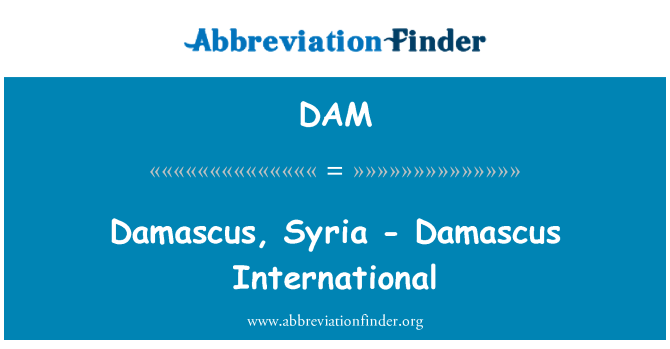Damascus, Arab Dimaschk esh-shame, French Damas [da ma], capital of Syria, and of the Governorate of Damascus, 690 m above sea level, on the eastern slope of the Anti-Lebanon, irrigated in the river Barada and canals oasis of Ghouta, (2010) 1.83 million residents.
Damascus is one of the most important historical centers in the Middle East with a university (founded in 1923) and an Arab Academy (1919), a national museum and library; Seat of the Greek Orthodox, the Syrian Orthodox (“Jacobite”) and the Melkite Patriarch of Antioch, a Syrian Catholic Archbishop, an Armenian Bishop (Etschmiadzin Catholic), a Latin titular Archbishop, a Vicariate of the Maronite Patriarch and an Aryanite Patriarch -Cathlian Patriarchate of Cilicia. The industry is limited to the textile, food, printing and cement industries. The handicrafts tie in with local traditions of the Middle Ages (silk brocade, wood inlays, copper utensils, damask, Damascus blades); international fair; Junction of important traffic routes, among other things. to Aleppo, Amman, Mecca, Beirut; international Airport.
History
Archaeological finds show that the Damascus oasis dates back to the 3rd millennium BC. Was settled. The name of the city has been used since the 15th century BC. In the hieroglyphic-ancient Egyptian and cuneiform tradition. Damascus was founded by Pharaoh Thutmose III. (1479–25 BC) and also belonged to the Egyptian Empire in the Amarna period (mid-14th century BC). In the early 1st millennium BC Damascus, now an Aramaic city-state, benefited from the donkey and camel caravans that crossed the Syrian desert from Mesopotamia or southern Arabia and headed for ports on the Mediterranean Sea; it was therefore also referred to as “the (city) of their donkeys”. In the 9th century BC Damascus was at the head of a Syrian coalition that opposed the Assyrian advance. Hazael of Damascus was then by Shalmaneser III. (858-824) subjected; later the Babylonians and Persians conquered the city. 332 BC Chr. Took Alexander the Great Damascus possession, after his death it became part of the Seleucid Empire. From 66 BC At the time of Pompey, Damascus belonged to the Roman Empire, from 395 AD to the Eastern Roman (Byzantine) Empire; Emperor Hadrian made Damascus the capital of the province of Syria in the 1st century AD. The Aramaic weather god sanctuary was transformed into a temple of Jupiter, which was then converted into a three-aisled Christian basilica (St. John’s Church) at the end of the 4th century (today the site of the Umayyad Mosque).
After it was captured by the Muslim Arabs (636), Damascus, at that time with a predominantly Aramaic, Christian and Jewish population, was the residence of the governor Moawija I from 639, who also stayed here as a caliph (from 661), makingthe place the capital of the Empire of the Umayyads and made the center of Arab-Islamic politics and culture. Even then, large parts of the population began to turn to Islam, during John of Damascus, Son of the caliph’s treasurer, wrote fundamental works on Orthodox theology. After the Umayyads fell in 749/750, the Abbasids moved their center to (present-day) Iraq. Damascus became the provincial capital and lost its importance. Fought for differently between Muslim rulers, Damascus came under the rule of the Egyptian Tulunids in 878, the Ichschidids in 945, the Fatimids in 970-1076 and remained mostly politically connected to Egypt during the Middle Ages, but was often the source of internal unrest. After 1104 Damascus became the seat of a dynasty of the Seljuks (Burids); then Damascus won as the residence of the Sengid Nur ad-Din (since 1154) and the Aijubid Saladin (1174–93) Importance as a Muslim base in the fight against the Crusaders. The population and economic activity rose again. Damascus became an important center of religious learning in the 13th century, partly taking over the legacy of Iranian and Iraqi cities after the Mongol invasion. Various important buildings were built: mosques, madrasas, large bazaars and warehouses, caravanserais and others, which – like the division into closed districts of the individual denominations – still give the city its character today.
The Mamluks, ruling since 1250, were able to assert Damascus against the Ilkhane (1260) and Timur (1401). Damascus was the second city of the Egyptian-Syrian Mamluk Empire. With its collapse, Damascus fell to the Ottoman Turks (under Sultan Selim I) in 1516. Among them, it was economically favored, especially as a starting point for the pilgrimage to Mecca, so that the residents could continue the expansion of the city. Since the 19th century (briefly occupied by Egypt in 1831-40) Damascus was an important center of the (east) Arab national movement (especially from 1878). On September 30, 1918, Arab-British troops occupied the city and ended the Ottoman rule. Damascus remained under the control of Feisal I until 1920 .; In 1920 Damascus became the capital of the French League of Nations mandate Syria (1925/26 center of anti-French unrest), and in 1946 the independent Republic of Syria.
City Profile
- Abbreviation: DAM
- Country: Syria

List of Damascus Acronyms
The most commonly used abbreviations for Damascus is DAM which stands for Damascus. In the following table, you can see all acronyms related to Damascus, including abbreviations for airport, city, school, port, government, and etc.
| City | Abbreviation | Meanings |
| Damascus | DISCOUNT | Damascus College |
| Damascus | DC | Damascus College |
| Damascus | DUMC | Damascus United Methodist Church |
| Damascus | JTD | Journey to Damascus |
| Damascus | DCE | Damascus Cutting Effect |
| Damascus | DHS | Damascus High School |
| Damascus | DCC | Damascus Chamber of Commerce |
| Damascus | DSE | Damascus Securities Exchange |
| Damascus | DAM | Damascus, Syria – Damascus International |
| Damascus | CFD | Committee for the Future of Damascus |


